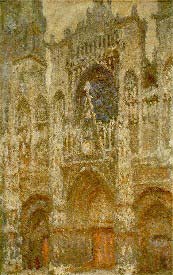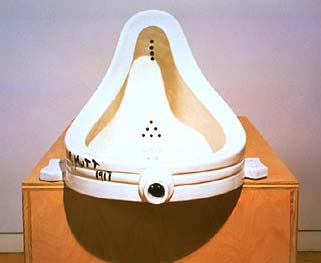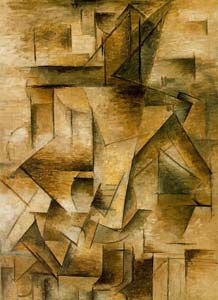|

David, Jacques-Louis
Napoleon en su Estudio
1812
Oleo en canvas
80 1/4 x 49 1/4 in. (203.9 x 125.1 cm)
The
National Gallery of Art, Washington, D.C.
En esta foto hecha por el pintor David ,ese es su apellido, vemos a Napoleón en su estudio. Aunque es un líder moderno el
nuevo emperador está rodeado de cosas que nos recuerda la antigua Roma, como las decoraciones en su silla y en su escritorio.
Napoleón pensaba que Francia sería como una nueva Roma, poderosa y dueña del mundo. El emperador empleó pintores como David
para llevar este mensaje.

El Juramento de los Horatii
David, Jacques-Louis
El Juramento de los Horatii
1784
Oleo en canvas
130 x 167 1/4 in. (330 x
425 cm)
Musee du Louvre, Paris
Esta pintura representa a unos hermanos que se van a pelear por su patria y a
lo mejor jamás regresarán. Sus mujeres lloran al fondo. El emperador esperaba lo mismo de sus ciudadanos. Napoleón esperaba
lo mismo de sus tropas.

Monet, Claude
La cathedrale de Rouen, le portail, temps gris ( Catedral de Rouen , Portal Oeste, Clima Nublado)
fechado
1894, pintado en 1892
Oleo en canvas
39 3/8 x 25 5/8 pulgadas. (100 x 65 cm)
Musee d'Orsay, Paris

MARCEL DUCHAMP | Fountain | 1917/1964
Perhaps no work is more singularly identified with the transformation
of art in the twentieth century than Fountain (1917) by Marcel Duchamp (1887-1968). Rejected from an exhibition that was to
be open to all works of art sponsored by the Society for Independent Artists in New York, the porcelain urinal was to become
the most important and notorious of the "ready-mades," which revolutionized the possibilities for artmaking through
their direct use of manufactured consumer products.
Duchamp acquired the lavatory urinal for the original Fountain
directly from J. L. Mott Iron Works, a manufacturer of plumbing equipment. Before submitting the piece to the exhibition as
sculpture, the artist rotated the urinal ninety degrees from its normal, functional position, and left the piece unimbellished
except for the inscription "R. Mutt 1917" (a pseudonym that synthesised the name of the manufacturer and that of
the popular comic strip "Mutt and Jeff").
The original Fountain has long since disappeared. In 1964, Duchamp
entrusted the Galleria Schwarz in Milan with the production of a signed and numbered edition of his most important ready-mades.
Each ready-made was refabricated by a highly exacting craftsperson to exactly replicate the original; the edition for each
selection was limited to eight signed examples. The highly esteemed Arturo Schwarz edition of Fountain is the fourth full-scale
version of the piece and the one that most closely approximates the lost original.
This is the only edition to be
issued under the direct supervision of Duchamp at every stage of the project on the basis of a blueprint derived from photos
of the lost original. Marcel Duchamp remains a singular voice in the history of modern art whose formal and conceptual innovations
have had vast implications for generations of artists to follow. Other works by Duchamp in the SFMOMA collection are Boîte
verte (Green Box), from 1934, and Boîte-en-valise (Box in a Suitcase), from 1938-42.
glazed ceramic with black paint
14 x 19 5/16 x 24 5/8 in. 1/8
Collection SFMOMA
Purchased through a gift of Phyllis Wattis
Copyright
© 2000 San Francisco Museum of Modern Art
tomado de artchive

Text from Thomas Hoving, "Art For Dummies®"
"Yet Cubism and Modern art weren't either scientific or
intellectual; they were visual and came from the eye and mind of one of the greatest geniuses in art history. Pablo Picasso,
born in Spain, was a child prodigy who was recognized as such by his art-teacher father, who ably led him along. The small
Museo de Picasso in Barcelona is devoted primarily to his early works, which include strikingly realistic renderings of casts
of ancient sculpture.
"He was a rebel from the start and, as a teenager, began to frequent the Barcelona cafes
where intellectuals gathered. He soon went to Paris, the capital of art, and soaked up the works of Manet, Gustave Courbet,
and Toulouse-Lautrec, whose sketchy style impressed him greatly. Then it was back to Spain, a return to France, and again
back to Spain - all in the years 1899 to 1904.
"Before he struck upon Cubism, Picasso went through a prodigious
number of styles - realism, caricature, the Blue Period, and the Rose Period. The Blue Period dates from 1901 to 1904 and
is characterized by a predominantly blue palette and subjects focusing on outcasts, beggars, and prostitutes. This was when
he also produced his first sculptures. The most poignant work of the style is in Cleveland's Museum of Art, La Vie (1903),
which was created in memory of a great childhood friend, the Spanish poet Casagemas, who had committed suicide. The painting
started as a self-portrait, but Picasso's features became those of his lost friend. The composition is stilted, the space
compressed, the gestures stiff, and the tones predominantly blue. Another outstanding Blue Period work, of 1903, is in the
Metropolitan, The Blind Man's Meal. Yet another example, perhaps the most lyrical and mysterious ever, is in the Toledo Museum
of Art, the haunting Woman with a Crow (1903).
"The Rose Period began around 1904 when Picasso's palette brightened,
the paintings dominated by pinks and beiges, light blues, and roses. His subjects are saltimbanques (circus people), harlequins,
and clowns, all of whom seem to be mute and strangely inactive. One of the premier works of this period is in Washington,
D.C., the National Gallery's large and extremely beautiful Family of Saltimbanques dating to 1905, which portrays a group
of circus workers who appear alienated and incapable of communicating with each other, set in a one-dimensional space.
"In 1905, Picasso went briefly to Holland, and on his return to Paris, his works took on a classical aura with large
male and fernale figures seen frontally or in distinct profile, almost like early Greek art. One of the best of these of 1906
is in the Albright-Knox Gallery in Buffalo, NY, La Toilette. Several pieces in this new style were purchased by Gertrude (the
art patron and writer) and her brother, Leo Stein. The other major artist promoted by the Steins during this period was Henri
Matisse, who had made a sensation in an exhibition of 1905 for works of a most shocking new style, employing garish and dissonant
colors. These pieces would be derided by the critics as "Fauvism," a French word for "wild beasts." Picasso
was profoundly influenced by Matisse. He was also captivated by the almost cartoon-like works of the self-taught "primitive"
French painter Henri "Le Douanier" Rousseau, whom he affectionately called "the last ancient Egyptian painter"
because his works have a passing similarity to the flat ancient Egyptian paintings.
"A masterpiece by Rousseau
is in the Museum of Modern Art in New York, his world-famous Sleeping Gypsy, with an incredible tiger gazing at the dormant
figure with laser-like eyes.
"Picasso discovered ancient Iberian sculpture from Spain, African art (for he haunted
the African collections in the Musée d'Ethnographie du Trocadéro in Paris), and Gauguin's sculptures. Slowly, he incorporated
the simplified forms he found in these sources into a striking portrait of Gertrude Stein, finished in 1906 and given by her
in her will to the Metropolitan Museum. She has a severe masklike face made up of emphatically hewn forms compressed inside
a restricted space. (Stein is supposed to have complained, "I don't look at all like that," with Picasso replying,
"You will, Gertrude, you will.") This unique portrait comes as a crucial shift from what Picasso saw to what he
was thinking and paves the way to Cubism.
"Then came the awesome Les Demoiselles d'Avignon of 1907, the shaker
of the art world (Museum of Modern Art, New York). Picasso was a little afraid of the painting and didn't show it except to
a small circle of friends until 1916, long after he had completed his early Cubist pictures. Cubism is essentially the fragmenting
of three-dimensional forms into flat areas of pattern and color, overlapping and intertwining so that shapes and parts of
the human anatomy are seen from the front and back at the same time. The style was created by Picasso in tandem with his great
friend Georges Braque, and at times, the works were so alike it was hard for each artist quickly to identify their own. The
two were so close for several years that Picasso took to calling Braque, "ma femme" or "my wife," described
the relationship as one of two mountaineers roped together, and in some correspondence they refer to each other as "Orville
and Wilbur" for they knew how profound their invention of Cubism was.
"Every progressive painter, whether
French, German, Belgian, or American, soon took up Cubism, and the style became the dominant one of at least the first half
of the 20th century. In 1913, in New York, the new style was introduced at an exhibition at the midtown armory - the famous
Armory Show - which caused a sensation. Picasso would create a host of Cubist styles throughout his long career. After painting
still-lifes that employed lettering, trompe l'oeil effects, color, and textured paint surfaces, in 1912 Picasso produced Still-Life
with Chair-Caning, in the Picasso Museum in Paris, which is an oval picture that is, in effect, a cafe table in perspective
surrounded by a rope frame - the first collage, or a work of art that incorporates preexisting materials or objects as part
of the ensemble. Elements glued to the surface contrasting with painted versions of the same material provided a sort of sophisticated
double take on the part of the observer. A good example of this, dubbed Synthetic Cubism, is in the Picasso Museum, Paris,
the witty Geometric Composition: The Guitar (1913). The most accomplished pictures of the fully developed Synthetic Cubist
style are two complex and highly colorful works representing musicians (in Philadelphia and the Museum of Modern Art, New
York). He produced fascinating theatrical sets and costumes for the Ballet Russe from 1914 on, turned, in the 1920s, to a
rich classical style, creating some breathtaking line drawings, dabbled with Surrealism between 1925 and 1935, and returned
to Classicism.
"At the outbreak of the Spanish Civil War, Picasso was appointed the director of the Prado. In
January, 1937, the Republican government asked him to paint a mural for the Spanish pavilion at the world exposition in Paris.
Spurred on by a war atrocity, the total destruction by bombs of the town of Guernica in the Basque country, he painted the
renowned oil Guernica in monochrome (now in Madrid's Museo Nacional Centro de Arte Reina Sofia.) Something of an enigma in
details, there's no doubt that the giant picture (which until the death of Franco was in New York's Museum of Modern Art)
expresses a Goyaesque revulsion over the horrors man can wreak upon fellow man. The center is dominated by a grieving woman
and a wounded, screaming horse illuminated, like Goya's Third of May, 1808 by a harsh light.
"Picasso lived
in Paris through the war, producing gloomy paintings in semi-abstract styles, many depicting skulls or flayed animals or a
horrifying charnel house. He joined the Communist party after the war and painted two large paintings condemning the United
States for its involvement in the Korean War (two frightfully bad paintings about events that never happened - like American
participation in germ warfare). He turned enthusiastically to sculpture, pottery, and print-making, and, in his later years,
preoccupied himself with a series of mistresses and girlfriends, changing his style to express his love for each one, and,
finally, making superb evocations of the works of old masters like Diego Velazquez. Whatever Picasso had a hand in turned
out to have an unquenchable spark of utter genius."
|



